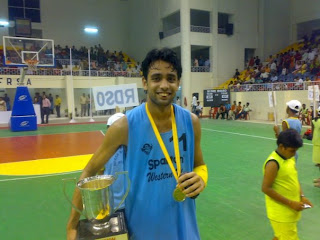National Basketball Championships have been held in India before – 60 times before to be exact – but there is something special about the 61st. Something different. The cheers are louder. The lights are brighter. The passes are so crisp that you can hear them zoom by.
The best Indian players in the business are displaying their talents at the 61st IMG-Reliance National Basketball Championship in New Delhi with the biggest prize in Indian basketball at stake. There is no bigger stage for the biggest games in the country, and the national capital has stepped up to host this fierce competition. But what will make this championship truly memorable that it is the first year that the Basketball Federation of India (BFI) is receiving full sponsorship for its events by the IMG-Reliance partnership.
 As BFI’s secretary-general Harish Sharma said to reporters to Monday, basketball is indeed ready to take the next step and conquer India.
As BFI’s secretary-general Harish Sharma said to reporters to Monday, basketball is indeed ready to take the next step and conquer India.An electric atmosphere is greeting players and fans every day at the Talkatora Stadium and the Modern School at Barakhamba, where the games are being held. On Friday afternoon, Andhra Pradesh face a challenge from Chandigarh in a relatively quieter affair, but not lacking in drama and intensity. A trumpeting sound from the crowd screamed over the applause – it was no vuvuzela, but a cheaper and equally effective knock-off! At the Talkatora Indoor Stadium, the players rushed and hustled their sneakers over the squeaky bright wooden floor, looking like one of the best basketball-playing surfaces in the country. An LED screen atop the stands show the live action as it unfolds, and then show highlights from basketball around the world during the breaks, including from the international games and the NBA. Hip-Hop and Punjabi music blares during time-outs and quarter-ends. The AP-Chandigarh game enters crunch time, and the small crowd gets on their feet for the last few minutes. AP hold on to their nerves in their end, stretch out their lead, and pull off an impressive 15 point victory.
The crowd gets larger and louder as the sun goes down. atmosphere reaches fever pitch by the evenings, when the marquee teams like Indian Railways, Punjab, Tamil Nadu, Services, and of course, the hosts Delhi take centre-stage. Railways, who are the two time champions in both the men’s and women’s divisions, are once again the favourites to find their way to the Indian Basketball’s Promised Land!
 But the best thing about this kind of competition in India is the showcase of India as a cultural phenomenon itself. No matter where in India the players hailed from, they shared a common enthusiasm for basketball. On Friday alone, the Talkatora stadium bore witnesses to players communicating in Telugu, Marathi, Hindi, Punjabi, Kannada, Malayalam, Tamil, and English. It’s a snapshot of the complete picture of Indian on one basketball court, communicated through dribbles, jumpshots, and hustle plays.
But the best thing about this kind of competition in India is the showcase of India as a cultural phenomenon itself. No matter where in India the players hailed from, they shared a common enthusiasm for basketball. On Friday alone, the Talkatora stadium bore witnesses to players communicating in Telugu, Marathi, Hindi, Punjabi, Kannada, Malayalam, Tamil, and English. It’s a snapshot of the complete picture of Indian on one basketball court, communicated through dribbles, jumpshots, and hustle plays.The Talkatora stadium itself has become a temporary temple of sorts to Indian basketball’s finest. Fans walk cardboard cut-outs of their basketball idols, getting am impression of the ones who are making a name for themselves in the sport across the country: players like Shiba Maggon, Sambajhi Kadam, Riyazzudin, Akanskha Singh, Anitha P., and many others.
On the court itself the action hasn’t disappointed. With quick, on-point passing, awesome athletic ability, and some dead-eye sharp-shooting, the Nationals are serving as the perfect platform for Indian basketball fans to catch a glimpse of their country’s elite.
The tournament moves on to the Quarter-Final stage from the 2nd of January, and the Finals are scheduled to be held on the 4th. The stage for the biggest teams has been set; now all eyes will be on the biggest teams to step up and claim it!








































